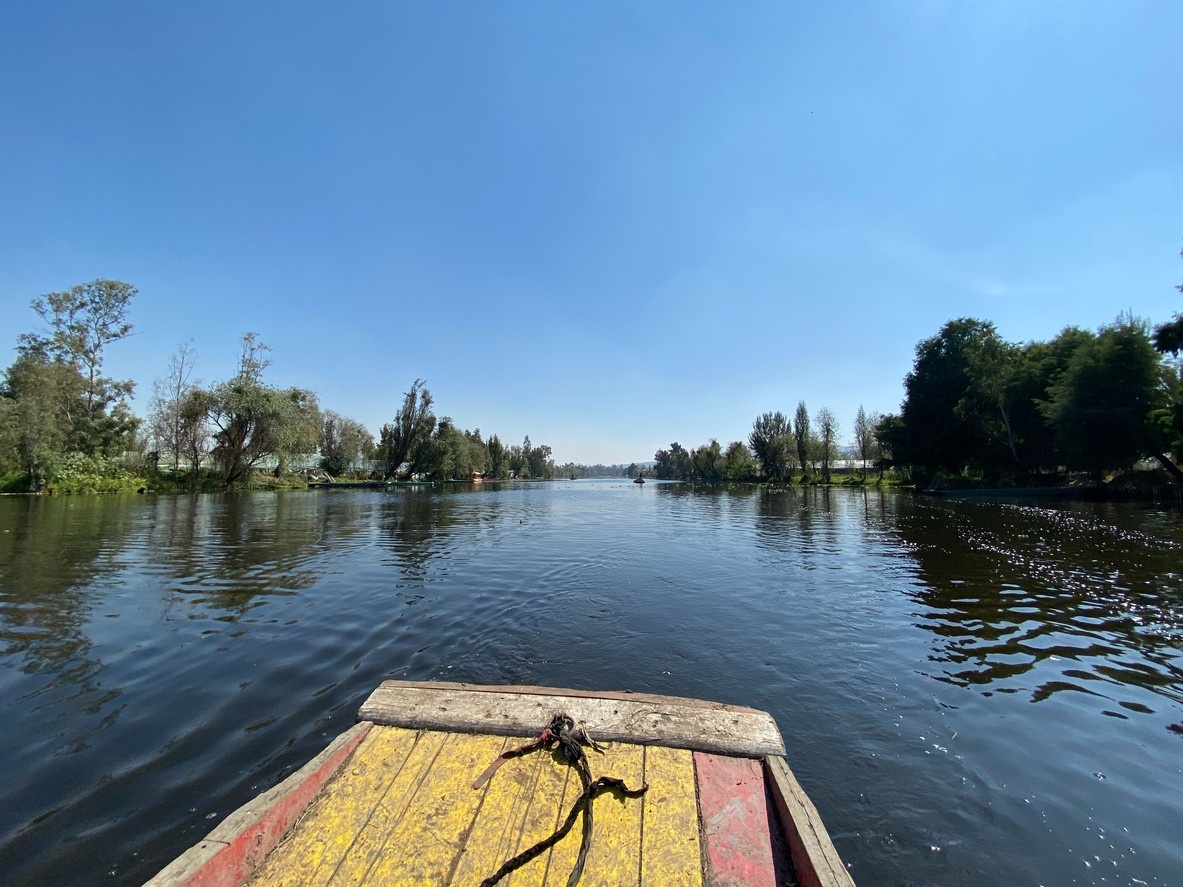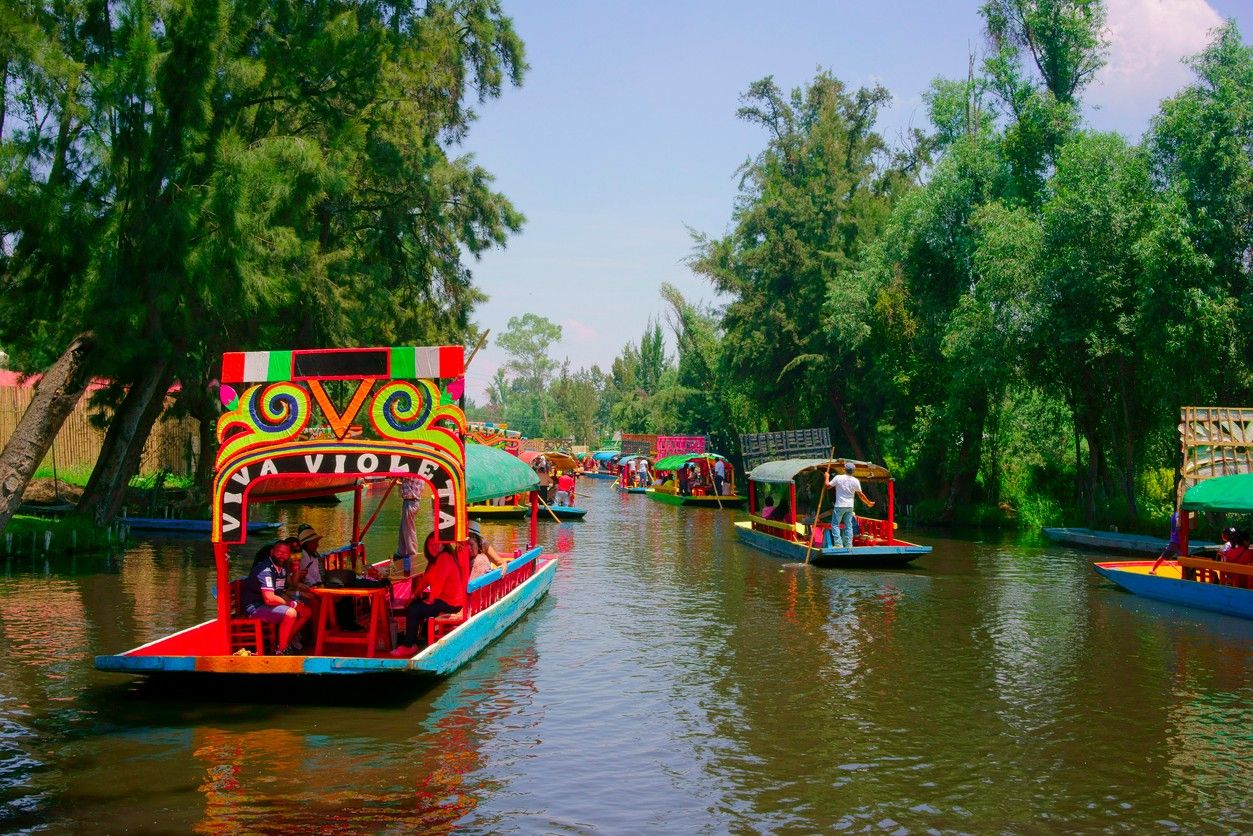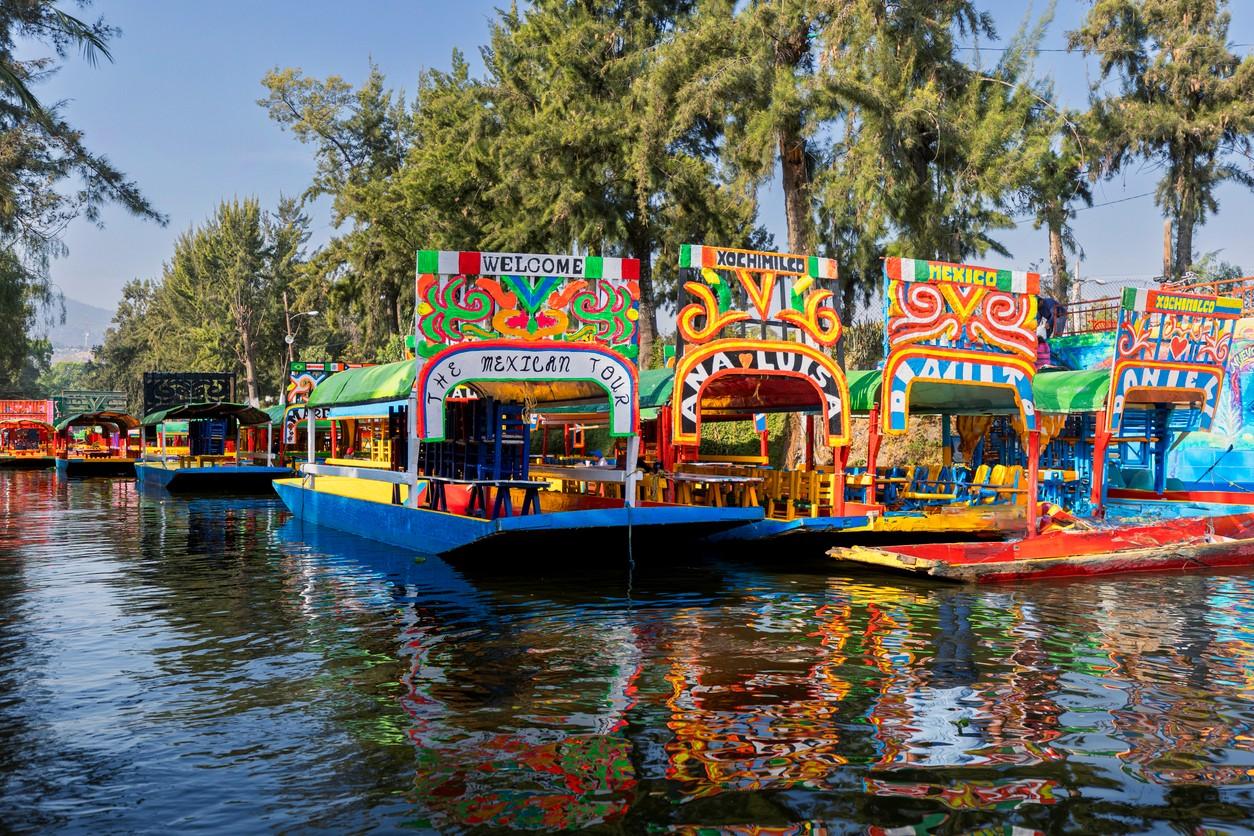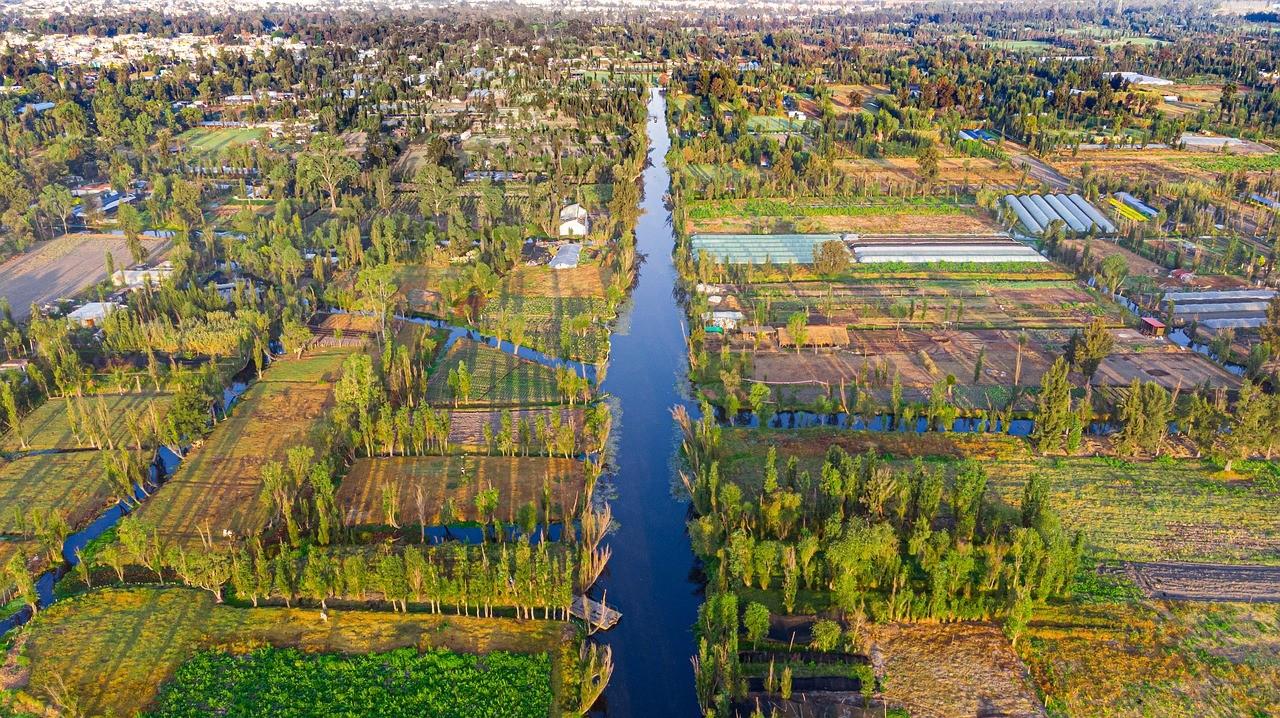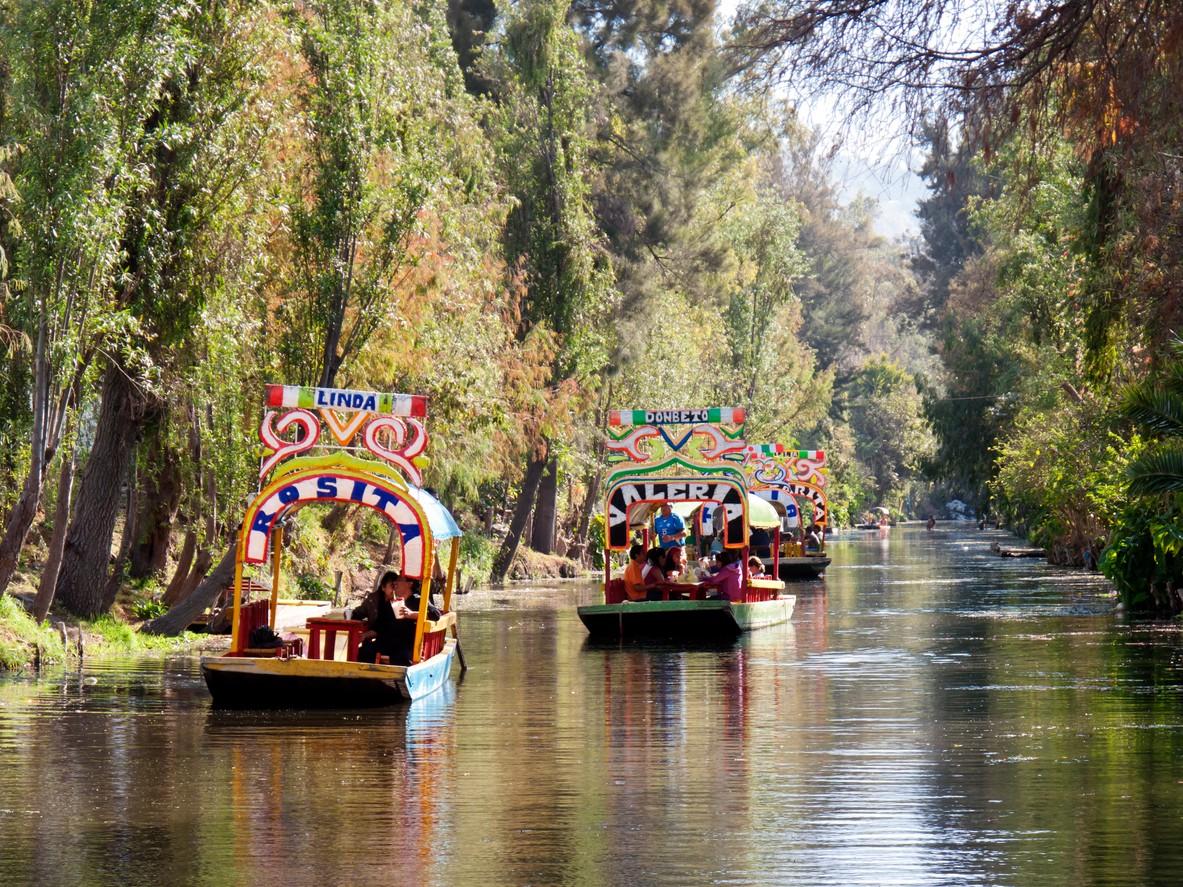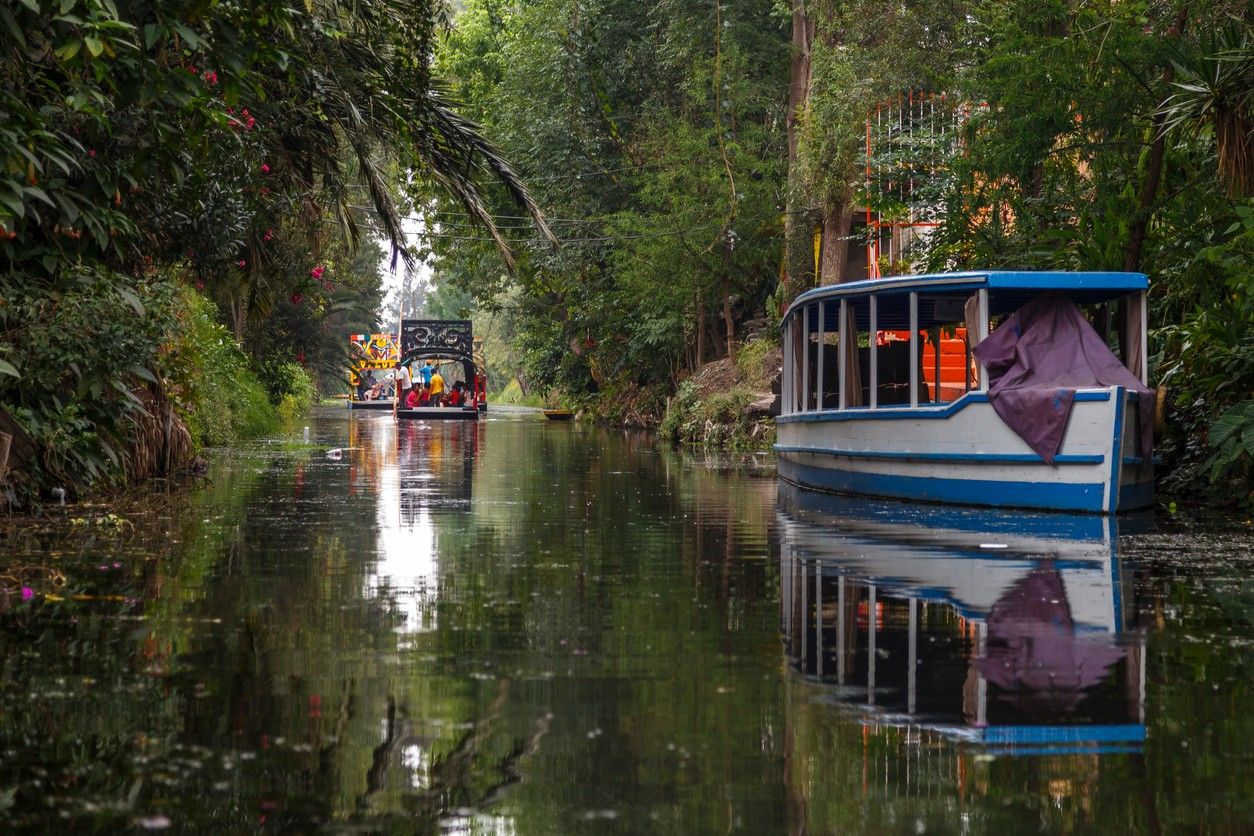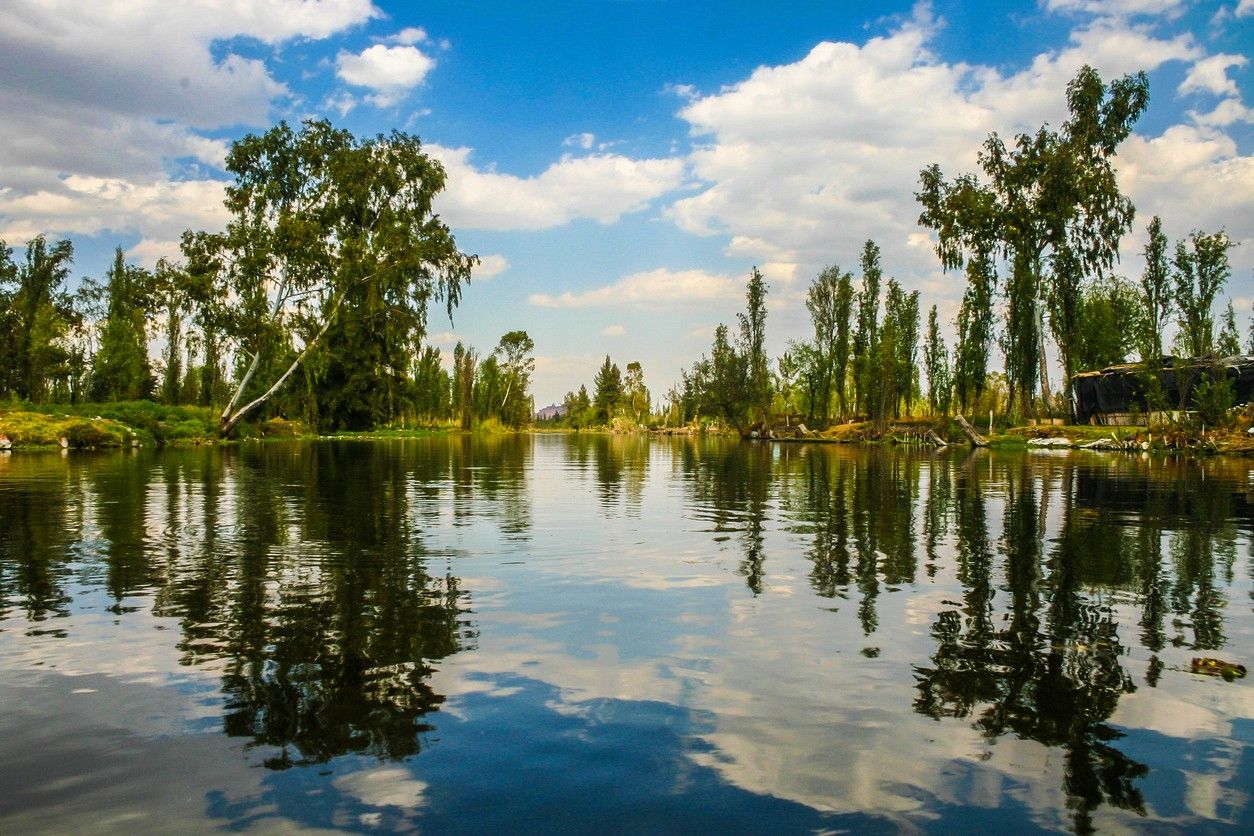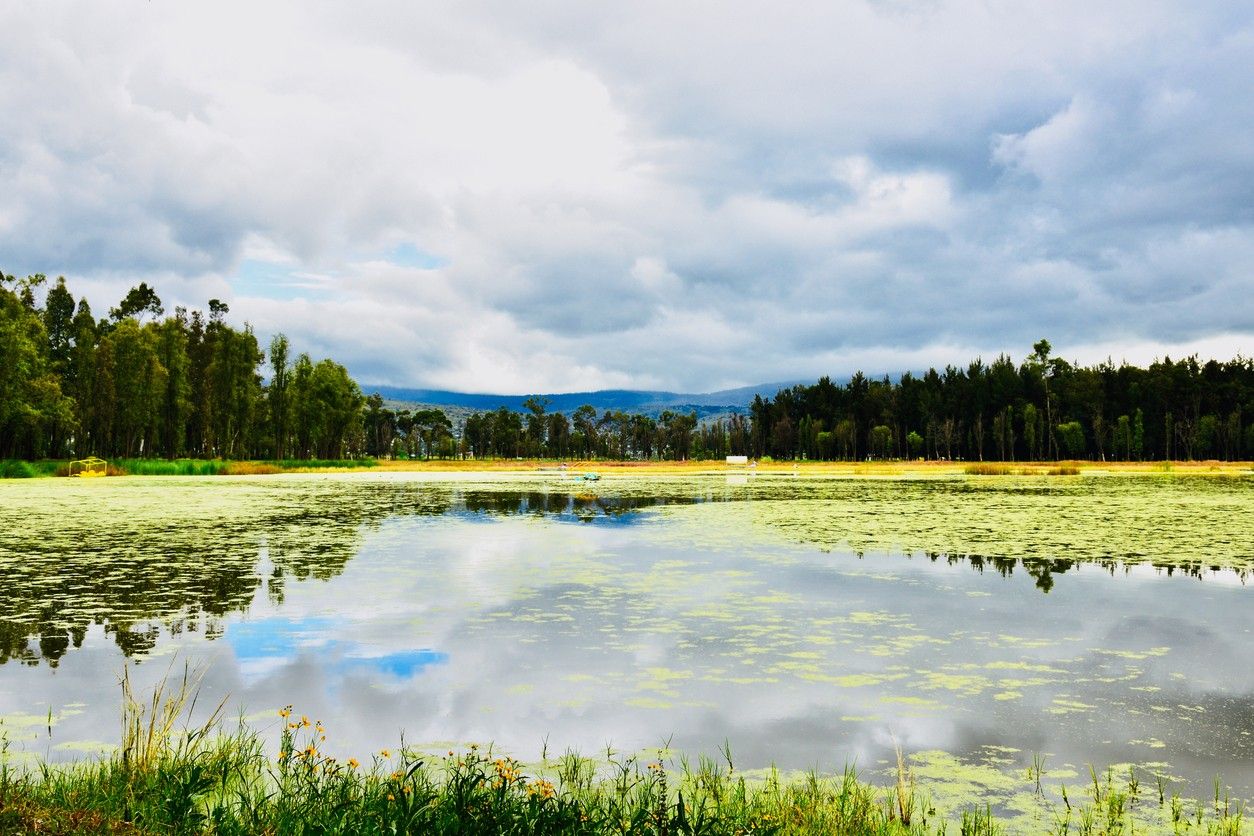Lake Xochimilco, located in the southern part of Mexico City, is a unique and fascinating destination that attracts visitors worldwide. This ancient lake system is a remnant of the vast lake and canal network that once covered the Valley of Mexico during the Aztec empire. The name "Xochimilco" comes from the Nahuatl language, meaning "place where flowers grow". The Aztecs created an extensive canal system and artificial islands called chinampas, which served as agricultural lands. These floating gardens were constructed by layering mud, vegetation, and tree branches on the shallow lake bed, anchored by willow trees. The fertile soil and abundant water supply made Xochimilco an important food source for the Aztec capital, Tenochtitlan. After the Spanish conquest in the 16th century, many of the lakes in the Valley of Mexico were drained to prevent flooding and create more land for urban development. However, Xochimilco survived and continued to thrive as an agricultural area. In the early 20th century, the Mexican government recognised the importance of preserving Xochimilco's unique ecosystem and cultural heritage. In 1987, Xochimilco was declared a UNESCO World Heritage Site, ensuring its protection and conservation for future generations. Today, Xochimilco is known for its colourful trajineras (flat-bottomed boats), floating gardens, and vibrant cultural traditions.
Exploring the Canals and Chinampas
The canals and chinampas (artificial islands) are the defining features of Lake Xochimilco. Chinampas are a centuries-old agricultural system built by piling layers of mud, vegetation and soil to create incredibly fertile land for crops. Visitors can explore the scenic canals and chinampas by riding in colourful trajineras (flat-bottomed boats) that are propelled by boatmen using poles. The chinampas support diverse plant life and provide habitat for many species of birds, fish and other wildlife
Riding the Trajineras
Riding the trajineras is an essential and unforgettable experience when visiting Xochimilco. These colourful, flat-bottomed boats have been a staple of the region for centuries, serving as a primary means of transportation and commerce along the intricate network of canals. Today, they offer visitors a unique and enchanting way to explore the beauty and history of this iconic destination. Trajineras come in a variety of sizes and styles, each one adorned with vibrant colours, and intricate designs, and often bearing the names of female figures or Mexican states. The boats are typically made of wood and feature a roofed section in the centre, providing shade and shelter from the sun. Visitors can choose to hire a trajinera for a few hours or even a full day, depending on their preferences and the extent to which they wish to explore the canals. The trajineras are propelled by a skilled boatman, known as a remero, who uses a long pole to gently guide the vessel through the calm waters. This traditional method of propulsion allows for a tranquil and leisurely experience, giving passengers ample time to take in the stunning surroundings, observe the daily life along the canals, and immerse themselves in the rich history and culture of Xochimilco. As the trajinera makes its way through the winding canals, visitors can marvel at the lush greenery of the chinampas, or floating gardens, that line the banks. These ancient agricultural islands, created by the Aztecs centuries ago, continue to thrive and provide a vibrant backdrop to the trajinera experience. Visitors can witness firsthand the ingenuity and resilience of the local farmers who tend to these gardens, growing a wide array of flowers, vegetables, and ornamental plants using traditional techniques passed down through generations.
The trajinera ride is not just a visual feast, but also a lively and engaging social experience. It is common for multiple trajineras to float alongside each other, creating a festive and communal atmosphere where passengers can interact, share stories, and even enjoy impromptu musical performances. Many trajineras come equipped with tables and chairs, allowing visitors to enjoy a picnic or a meal while taking in the sights and sounds of the canals. Some boats even feature onboard musicians who serenade passengers with traditional Mexican songs, adding to the joyful and authentic ambience. Throughout the journey, visitors can also take advantage of the many floating vendors who approach the trajineras, offering a tempting array of local snacks, refreshments, and handicrafts. From freshly grilled corn on the cob to handmade embroidered textiles, these vendors provide a delightful opportunity to sample the flavours and artistry of the region without ever having to leave the comfort of the boat. Many trajinera tours include stops at various points of interest along the canals. These stops allow visitors to disembark and explore the unique attractions, such as the enigmatic Island of the Dolls or the historic Cuemanco Boat Club, where they can learn about the traditional craftsmanship behind the construction and maintenance of trajineras.
Floating Gardens and Wildlife
The floating gardens, or chinampas, of Xochimilco, are a true marvel of human ingenuity and a testament to the harmonious relationship between people and nature. These ancient agricultural islands, created by the Aztecs over 500 years ago, have not only shaped the landscape of Xochimilco but also played a crucial role in the development and sustenance of the region's unique ecosystem. The chinampas are essentially artificial islands, constructed by layering mud, vegetation, and tree branches on the shallow lake bed. The Aztecs anchored these islands using willow trees, which helped to stabilise the soil and prevent erosion. Over time, the organic matter decomposed, creating a rich and fertile substrate that allowed for the cultivation of a wide variety of crops. This ingenious system of agriculture not only provided a reliable food source for the Aztec civilisation but also demonstrated their deep understanding of the natural environment and their ability to adapt to the challenges posed by the watery landscape.
Today, the chinampas continue to thrive as a living example of sustainable agriculture and a vital habitat for a diverse array of flora and fauna. Visitors to Xochimilco can witness the beauty and productivity of these floating gardens firsthand during a leisurely trajinera ride through the canals. As the boat navigates the waterways, passengers are treated to a stunning display of lush greenery, vibrant flowers, and thriving crops that seem to float effortlessly on the surface of the water. Many of the chinampas are still actively used for growing an assortment of flowers, vegetables, and ornamental plants, much as they were in ancient times. The local farmers, known as chinamperos, employ traditional techniques and knowledge passed down through generations to maintain the delicate balance of the ecosystem. They skillfully navigate the challenges of cultivating crops on these floating islands, using organic methods and carefully managing the water levels to ensure the health and productivity of the soil.
In addition to their agricultural significance, the chinampas also serve as a critical habitat for a wide range of wildlife. The wetlands of Xochimilco are home to many species of birds, including migratory waterfowl, herons, and egrets, which can be seen gracefully gliding across the water or perched on the edges of the islands. The canals themselves teem with life, supporting a variety of fish, amphibians, and reptiles that play essential roles in maintaining the ecological balance of the region. One of the most iconic and beloved species found in the waters of Xochimilco is the axolotl, a critically endangered salamander that is endemic to the area. Known for its unique appearance and remarkable ability to regenerate lost body parts, the axolotl has become a symbol of the importance of conservation efforts in the region. Visitors can learn more about these fascinating creatures and the ongoing efforts to protect them by visiting the Xochimilco Ecological Park or participating in guided nature tours.
The floating gardens of Xochimilco also provide a sanctuary for a diverse array of plant life, including many species that are native to the region. From the vibrant bougainvillea that cascades over the edges of the chinampas to the delicate water lilies that dot the surface of the canals, the flora of Xochimilco is a testament to the incredible biodiversity of the area. Visitors can marvel at the beauty of these plants and learn about their ecological and cultural significance through guided tours or by visiting the many nurseries and gardens that line the canals. In recent years, the floating gardens and wildlife of Xochimilco have faced numerous challenges, including urbanisation, pollution, and the introduction of invasive species. However, the local community and conservation organisations have been working tirelessly to protect and preserve this unique ecosystem. Through initiatives such as the Xochimilco Ecological Park, the Chinampa Preservation Project, and the promotion of sustainable tourism practices, there is hope that the chinampas and the wildlife they support will continue to thrive for generations to come.
Points of Interest Along the Canals
A ride through the canals of Xochimilco offers visitors the chance to discover several fascinating points of interest along the way. One of the most famous attractions is the Island of the Dolls (Isla de las Muñecas), a small chinampa that has gained notoriety for its eerie collection of dolls hanging from trees. According to local legend, a girl drowned near the island, and the dolls were placed there as a tribute to her spirit. The island's caretaker, Don Julián Santana Barrera, began hanging the dolls in the 1950s and continued to do so until he died in 2001. Today, visitors can disembark at the island and explore this unique and somewhat macabre site, which has become a popular destination for those seeking an unconventional experience. Another interesting stop along the canals is the Cuemanco Boat Club, where visitors can learn about the traditional techniques used to build and maintain trajineras. The club is dedicated to preserving the craftsmanship and cultural significance of these iconic boats, which have been an integral part of Xochimilco's history and identity for generations. Visitors can observe the skilled artisans at work and gain a deeper appreciation for the time and effort that goes into creating and maintaining these beautiful vessels.
Visiting the Church of San Bernardino de Siena is a must for those interested in the area's religious heritage. This historic church, located on the banks of the canals, dates back to the 16th century and is known for its beautiful Baroque architecture and ornate interior. The church is particularly important during the Niñopa Ceremony, which takes place on the fourth Friday of Lent and involves a procession of trajineras carrying a small ceramic figure of the Baby Jesus. Other notable points of interest include the Caltongo Ecological Park, a protected area that showcases the native flora and fauna of the region, and the Xochimilco Olympic Rowing and Canoeing Course, which hosted the rowing and canoeing events during the 1968 Summer Olympics. These sites offer visitors the opportunity to explore the natural beauty and sporting heritage of Xochimilco, adding depth and variety to their experience on the canals.
Cultural Traditions and Festivals
Xochimilco is rich in cultural traditions and hosts various festivals throughout the year that showcase its heritage. One famous event is the Niñopa Ceremony, a religious procession of flower-adorned trajineras carrying a revered child Jesus figure. The Day of the Dead at the beginning of November is another important celebration where cemeteries come alive with colourful altars and offerings to honour deceased loved ones. Music festivals, art exhibitions and food fairs also highlight the region's vibrant culture.
Niñopa Ceremony
The Niñopa Ceremony is a deeply significant and cherished tradition in Xochimilco that revolves around the veneration of the Niñopa, a 430-year-old image of the Child Jesus. This event takes place on the fourth Friday of Lent and involves a procession of trajineras, the colourful flat-bottomed boats that navigate the canals, carrying the Niñopa. The boats are beautifully decorated with flowers and religious symbols, creating a stunning visual spectacle on the water. The Niñopa is the most revered among Xochimilco's various Child Jesus images, which also include the Niño Dormidito, the Niño de Belén, the Niño Tamalerito, the Niño Grande, and the Niño de San Juan. Each year, a new mayordomo family is chosen to take care of the Niñopa and sponsor the numerous festivities and traditions associated with the image.
During the Ceremony, the image is transferred from the outgoing mayordomo family to the new one in a special mass held after Candlemas. The bishop presides over this event, taking the Niñopa from the outgoing mayordomos and presenting it to the new custodians. The ceremony attracts thousands of devoted followers from Xochimilco and beyond, many carrying photos and posters of the Niñopa. The Niñopa Ceremony is not only a religious event but also a celebration of Xochimilco's rich cultural heritage. Following the mass, everyone in attendance is treated to traditional foods such as mole, rice, pork, and tamales, showcasing the area's culinary delights. The ceremony is also associated with the blessing of seeds for good harvests and the blessing of candles, which incorporates a pre-Hispanic element into the festivities.
The Niñopa's influence extends beyond the annual ceremony, as the image is taken on visits to the sick and is believed to have miraculous healing powers. One notable story involves a mayordomo who accidentally dropped the image, breaking its arm and damaging some lilies. Distraught, he asked for the Niñopa's forgiveness and arranged for various masses in its honour. Remarkably, the damaged lilies began to grow again, a testament to the faith and devotion surrounding the Niñopa. Witnessing the Ceremony offers a unique opportunity to experience the deep-rooted religious traditions and cultural richness of Xochimilco. The vibrant procession of trajineras, the fervent devotion of the followers, and the joyous celebration that follows the mass create an unforgettable experience for visitors. This centuries-old tradition continues to thrive, drawing people together in a shared expression of faith and community spirit.
Day of the Dead Celebrations
Xochimilco comes alive during the Day of the Dead celebrations on November 1st and 2nd, as the community pays tribute to their deceased loved ones in a vibrant and meaningful way. The cemeteries of Xochimilco are transformed into a sea of colour, with elaborate altars, candles, and offerings created by the residents. This ancient tradition is an integral part of Mexico's cultural heritage and is particularly significant in Xochimilco. Visitors to Xochimilco during the Day of the Dead have the opportunity to witness the incredible craftsmanship and dedication that goes into creating the altars. Each altar is unique, featuring photos of the deceased, their favourite foods and drinks, and traditional elements such as marigold flowers, sugar skulls, and papel picado (perforated paper). The altars serve as a way for families to remember and honour their loved ones, inviting their spirits to return and join in the celebrations. The atmosphere in Xochimilco during the Day of the Dead is a fascinating blend of solemnity and festivity. While the occasion is centred around remembrance and reflection, it is also a time for celebration and joy. Families gather at the cemeteries to share stories, enjoy traditional foods, and even listen to mariachi music. The belief is that the deceased would not want their loved ones to mourn, but rather to celebrate their lives and the continuity of life itself. Some families spend weeks preparing their offerings, incorporating intricate designs, sculptures, and even entire scenes depicting the lives of the deceased. The result is a visually stunning display that showcases the artistic talent and cultural richness of the community.
Visitors can also explore the markets and streets of Xochimilco during the Day of the Dead, where they will find a wide array of traditional crafts, foods, and decorations related to the celebration. From sugar skulls and chocolate coffins to pan de muerto (bread of the dead) and atole (a warm corn-based drink), there are plenty of opportunities to sample the flavours and traditions associated with this important holiday. Experiencing the Day of the Dead celebrations in Xochimilco offers a profound and unforgettable insight into Mexican culture and the community's strong connection to their ancestors. The beauty, creativity, and emotion poured into the altars and offerings serve as a testament to the enduring power of love and remembrance. By witnessing and participating in these celebrations, visitors can gain a deeper appreciation for the significance of this ancient tradition and the resilience of the human spirit.
Conservation and Sustainability
Preserving Xochimilco's delicate ecosystem and cultural heritage is an ongoing challenge in the face of urban development and environmental threats. The chinampas rely on traditional sustainable agriculture practices that have enabled them to thrive for centuries. Conservation efforts include the Xochimilco Ecological Park which protects over hectares of wetlands and chinampas, and initiatives to restore the ancient chinampa system through organic farming methods. Promoting sustainable tourism is also key to supporting the local community while safeguarding this unique cultural and natural treasure.
Environmental Challenges
Xochimilco, with its unique network of canals and chinampas (floating gardens), faces many environmental challenges that threaten the delicate balance of this important ecosystem. One of the most pressing issues is the encroachment of urban development on the wetlands and agricultural lands of Xochimilco. As Mexico City continues to grow and expand, the pressure to convert the chinampas and surrounding areas into housing and infrastructure projects has increased, leading to the loss of valuable green spaces and biodiversity. Another significant challenge is the pollution of the canals and waterways that form the backbone of Xochimilco's ecosystem. The water quality has been severely impacted by a combination of factors, including agricultural runoff, sewage discharge, and industrial waste. This pollution not only affects the health of the plants and animals that depend on the water but also poses risks to human health, particularly for the local farmers who rely on the canals for irrigation and the visitors who come to enjoy the area's natural beauty. The introduction of invasive species, such as water hyacinth and tilapia, has also hurt the native flora and fauna of Xochimilco. These non-native species can quickly dominate the ecosystem, outcompeting native plants and animals for resources and altering the delicate balance of the wetlands. The water hyacinth, in particular, has become a major problem, forming dense mats on the surface of the canals that impede navigation and reduce oxygen levels in the water, leading to the death of fish and other aquatic life.
Climate change is another looming threat to the future of Xochimilco. As global temperatures rise and weather patterns become more unpredictable, the chinampas and wetlands are increasingly vulnerable to droughts, floods, and other extreme weather events. These changes can have devastating consequences for the agricultural productivity of the chinampas, as well as the overall health and resilience of the ecosystem. Addressing these environmental challenges requires a concerted effort from a wide range of stakeholders, including government agencies, local communities, and conservation organisations. Efforts to promote sustainable urban development, improve water quality, control invasive species, and adapt to climate change are all critical to ensuring the long-term survival and vitality of Xochimilco's unique ecosystem. Despite the many challenges facing Xochimilco, there are also reasons for hope and optimism. The area's designation as a UNESCO World Heritage Site has helped to raise awareness of its ecological and cultural importance and has provided a framework for conservation and sustainable development efforts. Additionally, the local community has a deep connection to the land and a strong tradition of stewardship, which can be harnessed to support ongoing conservation and restoration projects. By working together to address these environmental challenges, it is possible to secure a brighter future for Xochimilco and its incredible network of canals, chinampas, and wetlands. Through a combination of innovative solutions, community engagement, and political will, this unique and valuable ecosystem can continue to thrive and inspire future generations.
Xochimilco Ecological Park
The Xochimilco Ecological Park is a shining example of the efforts being made to protect and preserve the unique ecosystem of Xochimilco. Spanning over hectares of wetlands and chinampas, this protected area serves as a vital buffer zone between the urban sprawl of Mexico City and the fragile canals and floating gardens that have sustained the local community for centuries. The park was established in recognition of the critical importance of Xochimilco's wetlands, not only for their ecological value but also for the essential services they provide, such as water filtration, flood control, and carbon sequestration. By setting aside this large tract of land for conservation and sustainable use, the park aims to strike a balance between the needs of the environment and the needs of the local community.
The park has an extensive network of walking trails and boardwalks, which allow visitors to explore the wetlands and chinampas up close without disturbing the delicate ecosystem. These trails wind through a variety of habitats, from dense reed beds and marshy areas to the lush green chinampas themselves, offering a unique perspective on the incredible biodiversity of the area. Along the way, visitors can spot a wide range of native plant and animal species, many of which are found nowhere else in the world. The park is home to over 200 species of birds, including migratory waterfowl, herons, and egrets, as well as numerous species of amphibians, reptiles, and mammals. The chinampas themselves are a testament to the ingenuity and resilience of the local farmers, who have been cultivating these floating gardens for generations using traditional techniques that are both sustainable and highly productive.
In addition to its ecological value, the Xochimilco Ecological Park also serves as an important educational and recreational resource for the local community and visitors alike. The park features several interpretive centres and exhibits that highlight the history, culture, and ecology of Xochimilco, as well as the ongoing efforts to protect and restore this unique ecosystem. Visitors can participate in guided tours, workshops, and hands-on activities that deepen their understanding and appreciation of the area's natural and cultural heritage. The park also plays a crucial role in supporting sustainable economic development in Xochimilco. By promoting eco-tourism and other low-impact activities, such as birdwatching, photography, and environmental education, the park helps to generate income and employment opportunities for the local community while minimising the negative impacts of tourism on the environment.
Perhaps most importantly, the Xochimilco Ecological Park serves as a powerful symbol of hope and resilience in the face of the many challenges facing this unique and valuable ecosystem. By demonstrating that it is possible to balance the needs of people and nature, the park inspires others to take action and work towards a more sustainable future for Xochimilco and beyond. As more and more people discover the beauty and significance of Xochimilco's wetlands and chinampas, the Xochimilco Ecological Park will continue to play a vital role in ensuring that this incredible ecosystem remains healthy and vibrant for generations to come. Through a combination of conservation, education, and sustainable development, the park offers a model for how we can work together to protect and celebrate the natural and cultural treasures that make Xochimilco such a special and beloved place.
Practical Information for Visitors
Best Time to Visit — If you plan to visit Lake Xochimilco, it's important to consider the best time to go. The dry season, which runs from November to April, is generally the most pleasant time to visit, with mild temperatures and less rainfall. However, it's worth noting that weekends and holidays can get very crowded, so it's advisable to arrive early in the morning to avoid the rush and ensure a more enjoyable experience.
Getting There — Xochimilco is easily accessible from Mexico City. One of the most convenient ways to reach the area is by taking the metro to the Tasqueña station and then transferring to the Tren Ligero (light rail), which goes directly to the Xochimilco embarcadero (boat dock). Alternatively, visitors can take a taxi or Uber from the city centre, which typically takes around 45 minutes to an hour, depending on traffic conditions.
Hiring a Trajinera — When hiring a Trajinera, it's essential to agree on the price and duration of the ride beforehand to avoid any misunderstandings or disagreements later on. Prices can vary depending on factors such as the size of the boat, the length of the tour, and any additional services like food or music.
It's customary to tip the boatman at the end of the ride, so be sure to have some cash on hand. By establishing clear expectations and being prepared, visitors can ensure a smooth and enjoyable experience on the canals of Xochimilco.
What to Bring — When visiting Xochimilco, it's important to come prepared for a day out on the water. Visitors should bring sunscreen, a hat, and plenty of water, as the sun can be intense, and it's easy to become dehydrated. Comfortable clothing and shoes are also recommended, as you may want to disembark and explore some of the chinampas or points of interest along the canals. Don't forget to bring a camera to capture the stunning scenery, vibrant colours, and unique experiences that Xochimilco has to offer. It's also a good idea to bring some cash for tipping, purchasing souvenirs, or trying local snacks and beverages.
Museums and Visitor Centres — For those interested in learning more about the history and ecology of Xochimilco, there are several museums and visitor centres in the area that offer valuable insights and information. The Museo Dolores Olmedo, for example, houses an impressive collection of pre-Hispanic artefacts and works by renowned Mexican artists such as Diego Rivera and Frida Kahlo. This museum provides a fascinating glimpse into the artistic and cultural heritage of Mexico. The Cuemanco Visitor Centre is another excellent resource for those seeking to understand the ecology and conservation efforts in Xochimilco. The centre offers guided tours and educational programs that focus on the chinampas and the importance of preserving this unique ecosystem. By visiting these museums and visitor centres, tourists can gain a deeper appreciation for the natural and cultural significance of Xochimilco.
Related articles

Let us know you agree to cookies
We use marketing, analytical and functional cookies as well as similar technologies to give you the best experience. Third parties, including social media platforms, often place tracking cookies on our site to show you personalised adverts outside of our website.
We store your cookie preferences for two years and you can edit your preferences via ‘manage cookies’ or through the cookie policy at the bottom of every page. For more information, please see our cookie policy.
